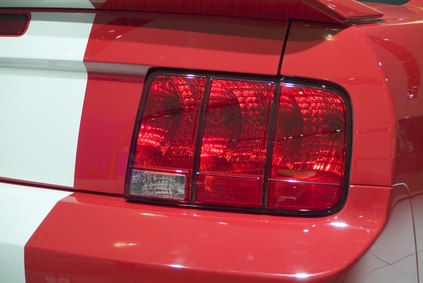
Ford's 289-cubic-inch V-8 is the second engine in the 90-degree V-8 series of engines, which began with the 221-cubic-inch V-8 in 1962. The 221 was followed by the 260 in 1963. Ford increased the stroke of the 260 to 3 inches to make the 289 in 1964. The other engines in the 90-degree V-8 series are the 302 and 351W. The 289 was produced from 1964 to 1968. The timing procedure for the 289 will work on any of the other 90-degree V-8 engines.
Run the engine until it reaches normal operating temperature. Park the vehicle on a level, paved surface. Set the parking brake.
Look at the area on the timing cover on the passenger's side of the engine, underneath the water pump. You will see the triangle-shaped timing pointer attached to the timing cover. It sets directly above the harmonic balancer, which is behind the crankshaft pulley. Look at the balancer for some numbers stamped on it. If you don't see the numbers, place a ratchet and socket on the large bolt in the center of the crankshaft and rotate the engine in a clockwise direction, looking at the front of the engine. When you see the numbers come into view, remove the ratchet and socket and spray the numbers with some parts cleaner and wipe off with a shop rag. Paint the numbers with some white-out to make them easier to see. The figures will state "20-10-TC-10," with little hashmarks between the numbers. The timing specification for the 289 is 6 degrees before top dead center. This will be the third hashmark before the TC.
Disconnect the vacuum advance line from the vacuum advance on the distributor and plug it with a plastic vacuum line plug.
Hook up your timing light by clipping the spark plug lead over the first spark plug wire on the passenger's side of the engine, then click the red lead to the positive battery terminal and the black lead to the negative battery terminal.
Use a wrench to loosen the bolt that secures the distributor; do not loosen it so much that the distributor turns freely.
Start the engine and aim the timing light at the pointer and harmonic balancer. Be careful of moving parts such as pulleys, fan belts and the fan blade. Note where the marks on the balancer line up with the pointer. If it's not on the third mark before the TC, turn the distributor until it is. When you have the mark properly aligned, tighten the distributor bolt and double-check your timing.
Turn off the engine. Remove the plug from the advance line and hook it back up to the distributor. Unhook the timing light.